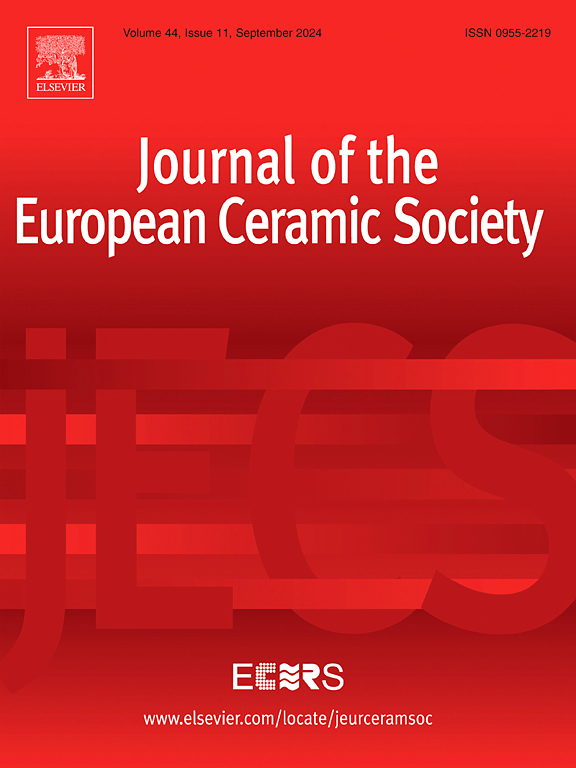Synthesis and comprehensive performance of magnesium tantalate ceramics
IF 6.2
2区 材料科学
Q1 MATERIALS SCIENCE, CERAMICS
Journal of The European Ceramic Society
Pub Date : 2025-05-26
DOI:10.1016/j.jeurceramsoc.2025.117562
引用次数: 0
Abstract
MgTa2O6 and Mg4Ta2O9 were synthesized separately based on the effects of temperature, preforming pressure, and morphology of raw material tantalum pentoxide on the phase composition and microstructure of magnesium tantalate. The comprehensive performance and manufacturing cost of MgTa2O6 and Mg4Ta2O9 ceramics were evaluated. The experimental results indicated that the optimum synthesis conditions of MgTa2O6 and Mg4Ta2O9 included type-I tantalum pentoxide as raw material, 100 MPa of preforming pressure, and 1260 °C for 10 h of temperature profile. Compared with MgTa2O6, Mg4Ta2O9 ceramic exhibited superior mechanical and thermal performance with a thermal conductivity of 1.94–3.02 W·m−1·K−1 across 100–1000 °C, coupled with a thermal expansion coefficient of 11.1 × 10−6 K−1 at 1000 °C and Vickers hardness of 7.11 GPa. Mg4Ta2O9 ceramic has the advantage of comprehensive performance and manufacturing cost relative to conventional rare earth tantalate and yttria stabilized zirconia (YSZ), which is a promising alternative for next-generation thermal barrier coatings (TBCs) applications.
钽酸镁陶瓷的合成及综合性能研究
基于温度、预成形压力和原料五氧化二钽的形貌对钽酸镁相组成和显微组织的影响,分别合成了MgTa2O6和Mg4Ta2O9。对MgTa2O6和Mg4Ta2O9陶瓷的综合性能和制造成本进行了评价。实验结果表明,合成MgTa2O6和Mg4Ta2O9的最佳条件为:以ⅰ型五氧化二钽为原料,预成型压力为100 MPa,温度分布为1260℃,温度分布为10 h。与MgTa2O6相比,Mg4Ta2O9陶瓷在100 ~ 1000℃时的导热系数为1.94 ~ 3.02 W·m−1·K−1,1000℃时的热膨胀系数为11.1 × 10−6 K−1,维氏硬度为7.11 GPa,具有优异的力学和热性能。与传统的稀土钽酸盐和钇稳定氧化锆(YSZ)相比,Mg4Ta2O9陶瓷具有综合性能和制造成本的优势,是下一代热障涂层(tbc)的理想替代品。
本文章由计算机程序翻译,如有差异,请以英文原文为准。
求助全文
约1分钟内获得全文
求助全文
来源期刊

Journal of The European Ceramic Society
工程技术-材料科学:硅酸盐
CiteScore
10.70
自引率
12.30%
发文量
863
审稿时长
35 days
期刊介绍:
The Journal of the European Ceramic Society publishes the results of original research and reviews relating to ceramic materials. Papers of either an experimental or theoretical character will be welcomed on a fully international basis. The emphasis is on novel generic science concerning the relationships between processing, microstructure and properties of polycrystalline ceramics consolidated at high temperature. Papers may relate to any of the conventional categories of ceramic: structural, functional, traditional or composite. The central objective is to sustain a high standard of research quality by means of appropriate reviewing procedures.
 求助内容:
求助内容: 应助结果提醒方式:
应助结果提醒方式:


